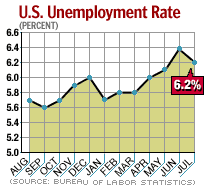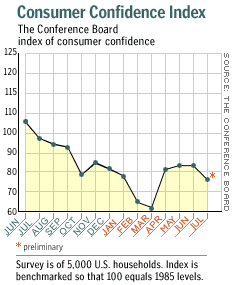NEW YORK (CNN/Money) -
Despite a recent wave of rosy reports on the U.S. economy and much optimism about the direction of growth, businesses still aren't hiring -- and some economists worry the labor-market slump, if it doesn't end soon, could nip the recovery in the bud.
Economic news Thursday from the Labor Department highlighted the promise and the danger for the job market. Weekly jobless claims stayed below a critical level for the third straight week, a sign things might be getting better.

And business productivity grew at a whopping annual rate in the second quarter, which is good news and maybe bad news. It's good news in that it means businesses were able to get a lot more work out of fewer workers, cutting their costs and raising their profits. The hope is that, when demand picks up in the second half, all that extra cash will go to expanding their business and hiring new workers.
"There must be some serious gains going on in either profits or wage rates," said Bill Cheney, chief economist at John Hancock Financial Services in Boston. "If it's going to profits, we should see more capital spending and hiring ahead, and if it's going to wages or lower prices, that should sustain consumption growth. Either way, it's good for the outlook."
| 
| |

| 
| 
|

|
 The unemployment rate fell in July, but not because businesses were creating jobs -- it's because more than a half million people took themselves out of the workforce. CNNfn's Lisa Leiter reports. The unemployment rate fell in July, but not because businesses were creating jobs -- it's because more than a half million people took themselves out of the workforce. CNNfn's Lisa Leiter reports.
|
 Play video
Play video
(Real or Windows Media)
|
| 
|

|
|
But it's bad news if all this productivity simply means U.S. businesses have learned to run lean and mean, and won't need to hire a battalion of workers when the upturn comes.
What's more, many of the workers they'll hire to perform business services, including information technology support and customer service, won't be in the United States. They'll be in places where labor and health-care costs are cheaper, such as India, China and the Philippines.
"More and more jobs, both manufacturing and service jobs, are sent overseas; these jobs won't come back any time soon," said Sung Won Sohn, chief economist at Wells Fargo & Co.
Confidence at risk
The two-faced nature of economic activity has left consumers unconvinced by the encouraging data and by policy makers and economists who promise prosperity is right around the corner.

Consumers haven't exactly stopped spending -- they almost never do, in fact -- but their confidence has begun to falter, mainly because the labor market apparently still hasn't gotten the news that the latest recession ended in November 2001.
Some economists fear that If job growth doesn't appear relatively soon, consumers -- whose spending fuels more than two-thirds of the total economy -- could go into hibernation, resulting in Recession II.
"If the job market doesn't kick into higher gear soon, consumers will lose confidence and rein in their spending, and the economy will in all likelihood fall back into recession unless we're very lucky," said Mark Zandi, chief economist at Economy.com.
In typical business cycles, higher productivity boosts corporate profits just as economic growth rebounds, so companies have more money to hire more workers to meet rising demand.
| Related stories
|

|
|
|
|
But productivity surged throughout 2002 at the fastest pace since 1950, and no new jobs were created, the unemployment rate rose and nine million people are now looking for work.
In fact, the economy has been growing steadily since the end of 2001, while payrolls still are underwater and have been for more than two years, the longest stretch since World War II.
"The economy continues to grow with fewer people working," said Sohn of Wells Fargo. "How long can we squeeze juice out of this orange? Not indefinitely. Sooner or later economic growth would suffer."
Can tax cuts bridge the gap?
Still, this doesn't mean U.S. employers are just never going to hire people again. Eventually, stronger growth should lead to a pickup in jobs.
The big question is the timing of that pickup, and many economists think it will take several months before the economy is growing fast enough to create 125,000 or so jobs per month, the level most economists believe is necessary to push down the unemployment rate.
Many economists think tax cuts and child-credit checks, along with the lingering positive effects of the recent wave of mortgage refinancings, will form a bridge to carry consumers -- and the economy -- to the promised land.
"The tax cuts appear to be perfectly timed, and the refis look pretty well-timed, since a huge surge occurred a month or so ago," said Lincoln Anderson, a former member of President Reagan's Council of Economic Advisers and now chief investment officer at LPL Financial Services in Boston.
But some of that tax-cut money will be spent on imported goods, which does nothing for the U.S. economy. In addition, some economists warn that, with consumers holding record levels of debt and interest rates rising rapidly, some of the tax-cut benefit might be muted as consumers choose to save some of their windfall.
"We hope it will be the case that tax cuts will bridge the gap until hiring picks up, but that seems like a pretty precarious plan," said Wachovia Securities economist Mark Vitner. "But it's the only plan we've got."

|

